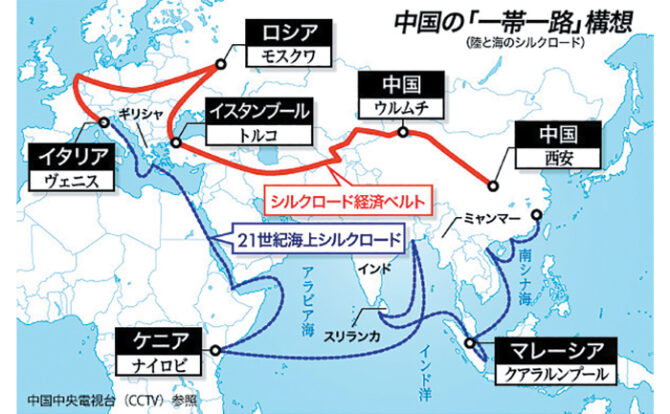
【Future of China's Belt and Road Initiative】
The 3rd Belt and Road Forum for International Cooperation was held in Beijing, China,on October 17 and 18, 2023. In 2013, Chinese President Xi Jinping launched the Belt and Road Initiative. It is a program to connect Asia with Europe and Africa through land and sea transportation networks, with the aim of increasing trade, and economic integration and stimulating growth. Over the past decade, as China's economic expansion into developing and emerging countries has progressed, various criticisms have been raised, such as China's excessive investment and lending, which has burdened developing countries with debts that cannot be repaid. Let's look back at the past 10 years.
【Belt and Road Initiative inspired by the Silk Road】
The Belt and Road Initiative (BRI) is inspired by t he a ncient Silk Road, a n etwork of t rade routes that connected China to Europe for centuries. The BRI consists of a "Silk Road Economic Belt", a transcontinental passage connecting western China with Central Asia and Europe by land, and a "21st Century Maritime Silk Road", a sea route connecting China's coastal regions with Southeast Asia, Sri Lanka, the coast of the Arabian Peninsula, and the east coast of Africa.
The BRI is a strategy initiated by the People's Republic of China to connect Asia with countries in the Middle East, Africa, and Europe by land and sea, with the goal of developing supply chains through roads, railways, and ports and supporting infrastructure and operating systems on a global basis to increase trade and stimulate economic growth.
【What is the background of the Belt and Road Initiative?】
China focused on domestic infrastructure development in preparation for the 2008 Beijing Olympics. China was in the midst of the biggest bubble
in its economy.
On the other hand, Japan and other Western countries were in the midst of a global recession caused by the bankruptcy of the American investment bank, Lehman Brothers, in September that year. Under these circumstances, China was the only country that invested huge amounts of money to rapidly develop various kinds of infrastructure, including highways, railways, telecommunications facilities, and housing. China's economic development was so remarkable that it was said that the global economic downturn caused by the bankruptcy of Lehman Brothers was stopped by China's economic growth.
However, once China's rapid infrastructure development reached a certain level, domestic demand began to decline. As a result, materials such as steel and cement became surplus. Consequently, China's desire to recoup its investment by exporting domestically overproduced materials to developing countries coincided with developing countries' desire to catch up on infrastructure development with Chinese assistance. This was exactly the time around 2013 when the Belt and Road Initiative was announced.
The number of countries participating in the Belt and Road Initiative expanded to include even Latin America and the South Pacific region.
【What is a "debt trap"?】
In recent years, however, the Belt and Road Initiative has been criticized for its approach to lending to developing countries. A case in point is the loan to Sri Lanka. Sri Lanka borrowed heavily from China to build a p ort. W hen Sri Lanka was unable to repay the loan for the port, it was forced to hand over control to China on a 99-year lease. As seen in this case, a debt trap occurs when China finances a huge project with no prospect of profitability, resulting in developing countries becoming overleveraged. It is estimated that eight other countries, including Mongolia, Laos, and Pakistan, have also fallen into the debt trap.
Italy, the only G7 country to be a member of the Belt and Road Initiative in 2019, is considering withdrawing from the BRI because its benefits are not as great as expected.
In response to these criticisms, President Xi Jinping addressed the international community at the 2019 Belt and Road Forum, saying, "We will provide sustainable financial support based on international rules, while respecting the laws of each country." Forced to make a course correction, China, which lost the momentum of economic growth due to the COV ID-19 pa ndemic,announced a policy of focusing on smaller projects based on realistic financial plans, such as in the digital and environmental sectors.
【Future of China's Belt and Road Initiative】
The Belt and Road Initiative was originally intended to create an economic zone spanning Asia, the Middle East, and Europe. However, the "Pearl Necklace Strategy," which promotes port development for expansion into the Indian Ocean, and the construction of online networks in areas
surrounding the Belt and Road, known as the "Digital Silk Road," are major threats to Western countries. Some argue that the Belt and Road Initiative is "neo-colonialism". It is necessary to carefully monitor its future development.
Rather than joining the Belt and Road Initiative, Japan chose to cooperate with China in third-party markets. In October 2018, China and Japan signed a wide-ranging agreement on strengthening bilateral ties, pledging to enhance cooperation to promote projects that benefit emerging countries and other third countries. Japan-China cooperation in Thailand's ongoing economic corridor program, which spans the eastern and western parts of the Indochina Peninsula, can be seen as a project that demonstrates the benefits of the Belt and Road Initiative and Japanese companies. In order for Japanese companies to engage in economic activities on the global stage, it is necessary to proceed cautiously while constantly examining China's claim that "the Belt and Road Initiative is essential for the development of Asia, corrects economic disparities among Asian countries, and is also effective for the development of the world".
